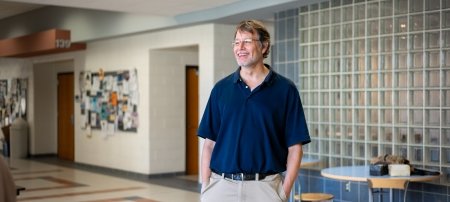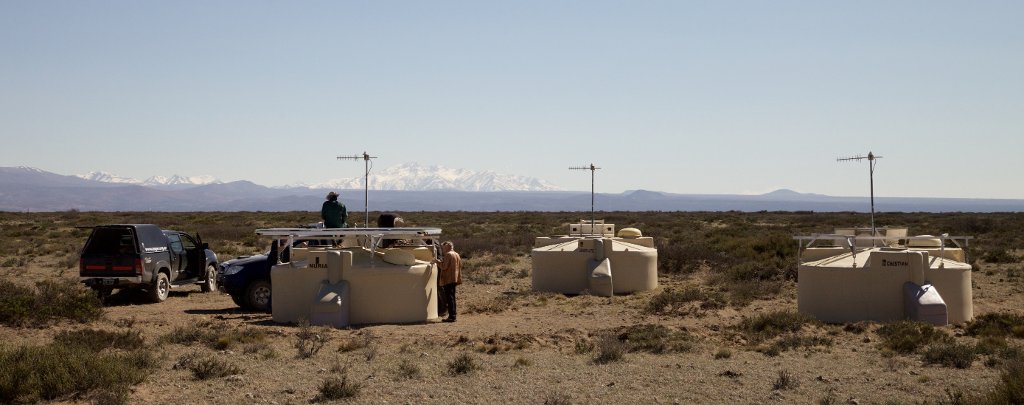Nemiroff Honored for Astrophysics Research
Note: The University is recognizing two faculty members with the 2012 Research Award, Robert Nemiroff and Andrew Storer. The article on Storer's accomplishments appears here.
From leading-edge research to extraordinary showmanship, few scientists have made as big an impact on their field as astrophysicist Robert Nemiroff, the co-recipient of Michigan Technological University’s 2012 Research Award.
Nemiroff, a professor of physics, is best known in the lay community for being half of the team behind NASA’s Astronomy Picture of the Day. With half a million hits daily, it is “the most successful and popular astronomy site on the web,” wrote Bradley E. Schaefer of Louisiana State University in support of Nemiroff’s nomination for the Research Award. “This is astounding, and the popular effect on astronomy perceptions and education throughout America and the world is enormous.”
Nemiroff and Jerry Bonnell of NASA started Astronomy Picture of the Day in 1995, which may make it the Internet’s first science blog. It has been going strong ever since. Said Jon Hakkila of the College of Charleston, “As a result of this webpage, Dr. Nemiroff has contributed greatly to popularizing astronomy, following in the footsteps of the late Dr. Carl Sagan.”
The site is so well known, that “some people in the astronomical community think that’s all I do,” said Nemiroff, adding with a smile, “It’s good to get a Research Award to show that I’m a real scientist.”
There doesn’t seem to be much doubt that he is. Nemiroff established himself years ago within the astrophysics community championing the idea that gamma-ray bursts—the most powerful explosions in the universe—originate far beyond the Milky Way. “The gamma-ray burst distance was one of the most profound unanswered questions in astronomy,” said Hakkila. Nemiroff’s “work helped convince many astronomers that GRBs originated in distant galaxies.”
“Our group back then had several indications that gamma-ray bursts weren’t galactic and could be cosmological,” Nemiroff said. To help settle the point, he organized the 1995 Great Debate between the leading proponents on each side of the issue, an event that was attended by hoards of professional astronomers.
Nemiroff's group showed time and again that new satellite observations were most consistent with a cosmological origin. They found differences between bright and dim gamma-ray bursts that could best be explained by the high-energy explosions occurring billions of light years away, in the deep cosmos. A serendipitous but definitive optical observation a few years later confirmed the suspicions of Nemiroff and a growing group of others: “It was game over for the galactic people.”
Most recently, Nemiroff and his team used a gamma-ray burst to suggest that space-time is not as “foamy” as some scientists think.
“There are theorists who hypothesize the universe is comprised of quantum foam at very small scale, with particles constantly coming and going out of existence,” he said. “You can’t show that in a lab, but if you record photons from a gamma-ray burst from across universe, you might see this effect. We found a millisecond spike at very high energy in one specific gamma-ray burst.”
If the universe were as foamy as predicted, it would have smeared the spike out, he said. “Foaminess” may kick in at some point, but at much smaller scales. “We found the universe is smooth. That surprised some theorists,” he said.
His research also capitalizes on a phenomenon predicted in Einstein’s General Theory of Relativity. Called gravitational lensing, it states that matter can bend light away from its source. “I use that to better understand the universe between gamma-ray bursts and us,” he said.
In nominating Nemiroff, physics professor Don Beck and Ravindra Pandey, chair of the physics department, cited his research based on gravitational lensing, noting that his groundbreaking predictions regarding binary stars, quasars and microlensing events (which give insight into stellar distributions and dark matter) have been proved correct.
In another project, Nemiroff and his graduate students searched gamma-ray bursts to find “echoes” caused by the gravitational lens effect of dark matter. “We couldn’t find the echoes,” he said, so they concluded that there was considerably less dark matter in the region than previously estimated, “about a billion solar masses.”
Among his other accomplishments, Nemiroff also led the first team to set up a global network of wide-angle cameras to record the entire night sky. While most of his original cameras are no longer in place, “in the sincerest form of flattery, several groups have since built their own [networks] with their own scientific emphasis,” Schaefer wrote.
The passion for education and outreach evident in the Astronomy Picture of the Day manifests itself throughout Nemiroff’s working life. “He really cares about teaching,” said Jay Norris of Boise State University. “Bob’s quest to understand Nature—and transfer that understanding to others—is unflagging.”
Schaefer noted that he has adopted Nemiroff’s “Ask Mr. Wizard” idea, in which he dons a wizard’s hat and invites introductory astronomy students to ask questions that won’t be covered in class. “It has worked wonderfully,” Schaefer said. “This is always the most-praised item in my end-of-semester evaluations.”
Outreach should go hand in hand with research, Nemiroff said. “Scientists should communicate outside their field, and many people are doing it here at Michigan Tech.”
And, he said, he’s honored by be singled out for his own contributions. “There’s a lot of really good science going on all around the University,” he noted. “You can go into many labs, ask what’s going on, and be enthralled.”
Michigan Technological University is a public research university founded in 1885 in Houghton, Michigan, and is home to more than 7,000 students from 55 countries around the world. Consistently ranked among the best universities in the country for return on investment, Michigan’s flagship technological university offers more than 120 undergraduate and graduate degree programs in science and technology, engineering, computing, forestry, business and economics, health professions, humanities, mathematics, social sciences, and the arts. The rural campus is situated just miles from Lake Superior in Michigan's Upper Peninsula, offering year-round opportunities for outdoor adventure.




Comments